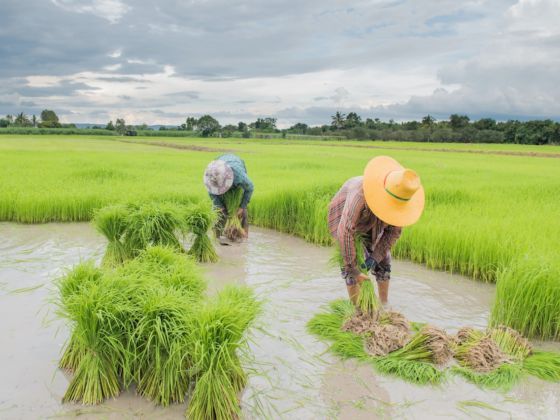SOUTHEAST ASIA IS OBJECTIVELY one of the most beautiful regions on Earth — it’s covered in dense jungle, it’s peppered with gorgeous beaches, and it’s full of incredible wildlife. It also has some spectacular urban centers, recently stimulated by massive economic growth.
Unfortunately, the act of pulling people out of poverty and into the developed world often comes at the expense of the local environment. This is true of all countries in this scenario, but it’s particularly acute for Southeast Asian nations, as their economies — especially the tourism sector — depend so fundamentally on pristine natural resources.
Most of the environmental issues in Southeast Asia are inextricably linked, and working to ameliorate one will often have added benefits for the others. Here are some of the problems, and some things you personally can do to help.
1. Endangered species conservation
The problem: Southeast Asia sits almost entirely in the tropics, and as such, is covered in rich, dense, biologically diverse jungle. As a result of a wide number of factors — from poaching to deforestation — many native species are endangered. One of the most prominent of these species is the Asian elephant. The total number of Asian elephants in the world has sadly fallen to below 30,000, down from 100,000 at the beginning of the 20th century in Thailand alonesrc.
Asian elephants are endangered for a number of reasons: First, they have been subject to ivory poaching. Though elephant poaching is illegal, there’s still plenty of demand for ivory, so it happens anyway. Second, they have experienced widespread habitat destruction, which simultaneously makes it harder to get food, and puts elephants into much more contact with humans, which can often result in the death of either the human or the elephant.
Elephants are by no means the only endangered species in Southeast Asia — the Sumatran tiger, the orangutan, and the Javan rhinoceros all face the threat of extinction. Some estimate that over 40% of all plant and animal species in Southeast Asia could go extinct during the 21st centurysrc.
How you can help: The name of the game here is conservation. In the broader scale, this means cracking down on poaching and supporting nature preserves. To help stop poaching, you can do a number of things: Never buy ivory or any other product obtained from an endangered species. Limiting demand is one of the first steps to ending poaching. You can also support organizations like the World Wildlife Fund that supply and support anti-poaching patrols.
Nature preserves are another partial solution. They provide a protected sanctuary for animals, and an area that is more or less safe from habitat destruction. You can support them by either donating to one of them specifically, or by going and visiting them yourself. Also, educate yourself!
2. Air pollution
The problem: Air pollution is a global problem, but Southeast Asia does have among the worst air pollution in the world, only behind East Asia and Indiasrc. The region is prone to relatively frequent “hazes,” which are the result of widespread fires. These fires are generally started intentionally by either small-scale farmers or companies trying to clear land of trees so they can exploit it the following year.
The hazes in Southeast Asia have become an increasingly frequent occurrence and can spread across many countries, causing serious health and safety concerns. The 2013 haze — mostly originating from fires in Indonesia — caused problems in Singapore, Brunei, Malaysia, Thailand, and Indonesia. During hazes, it can be hazardous to even go outside, so often cities will shut down, adding economic costs to the list of consequences.
How you can help: Air pollution is not a simple problem to solve, and in terms of fighting hazes in Southeast Asia, it’s even more difficult if you’re not living there. That said, we all share the same atmosphere, and working to reduce pollution where you are is useful to everyone on the planet. Work to conserve energy in your home, and try to reduce your overall carbon footprint (which, to be honest, is one of the best things you can do for pretty much all of the items on this list).
You can also support palm oil companies — among the worst offenders of the Indonesian slash-and-burn haze fires — that have zero-burn policies, and that refuse to work with third parties who use slash-and-burn techniques. Environmentalist and international pressure have already resulted in the world’s largest palm oil corporation, Wilmar International, taking such a step. You can also support organizations that push zero-burn policies.
3. Destruction of coral reefs
The problem: Southeast Asia is known for its incredible coral reefs, and, subsequently, its incredible diving. The area known as the “Coral Triangle” — mostly centered on the islands of Oceania — is the most biologically diverse marine environment in the worldsrc. Unfortunately, the reefs of Southeast Asia have been seriously degraded over the past several decades.
This is the result of several factors: First, the ocean absorbs about a quarter of all the carbon dioxide we put into the atmosphere each yearsrc. While this actually helps reduce the effects of global warming temporarily, it also means that more of that carbon is going to be converted into carbonic acid, increasing the ocean’s acidity level over time. This acidification fundamentally weakens coral reefs, making them more prone to disease, and less likely to recover from disturbances.
The second factor is overfishing. Not only does the widespread removal of fish species harm the coral reef ecosystem, but many of the methods used to catch the fish harm the system itself, such as blast fishing (the use of dynamite), and cyanide fishing (using sodium cyanide to stun the fish and capture them for personal aquariums).
A third factor is actually dive tourism. When divers visit coral reefs, they’ll often interfere with the ecosystem in a way that can damage it — whether by walking on the reefs or taking specimens home for themselves.
How you can help: There are a number of things you can do to protect Southeast Asian (and virtually all) coral reefs. The first, obviously, is to try and reduce your carbon footprint. Less carbon in the air means less carbon in the ocean, which means less carbonic acid damaging coral reefs. You can do this by simply driving less and walking or biking more, and by reducing your energy consumption.
If you’re an aquarium owner, make sure you’re buying ethically bred or captured fish — never buy cyanide-captured reef fish. Another important action to take is to ensure you’re eating seafood ethically. While this may mean reducing the seafood you eat, it doesn’t mean you have to cut fish out of your diet entirely — just make yourself aware of what fish in your area are the most sustainable to eat.
And finally, if you go diving at any of these reefs, be sure to use a dive operator that’s focused on sustainability and is aware of the threats to their local reef. The standard rule is, “Take only pictures, leave only bubbles.” If you’re in the area for a while, try volunteering in reef cleanups.
4. Deforestation
The problem: As cities and populations grow, more land area is needed. Often, this area is created out of forests. In Southeast Asia specifically, given its position in the tropics, much of the forest that’s destroyed is rainforest, one of the most biologically diverse ecosystems on the planet. Rainforests are not only home to more than half of the world’s plant and animal speciessrc, but they also provide over a quarter of our natural medicinessrc, and they absorb over a quarter of our planet’s carbon dioxidesrc.
So naturally, the effects of deforestation of rainforests can be catastrophic — not only does it destroy plant and animal habitats, but it also accelerates climate change and potentially deprives us of undiscovered life-saving medicines. Deforestation isn’t an easily solved problem either. Often, it happens because poor families need more space to plant their crops or simply need wood for fuel, or it may be a side effect of unintentional wildfires.
How you can help: Stopping deforestation altogether is not possible as long as there’s population growth. But there are ways to do it sustainably. For example, we can create international carbon offset programs. The best way for you to help push for this is to call your local representative, or to support an organization working on carbon offset campaigns. You can also make sure you’re buying recycled wood, or are buying from companies that commit to zero deforestation policies.
5. Water security
The problem: The world as a whole may well be close to reaching “peak water,” the point where we start consuming fresh water faster than it can be replenished. In few places is this concern as acute as it is in Southeast Asia. First off, the Himalayan glaciers that serve as the sources for many of the major Asian rivers — including the Mekong, which passes through China, Myanmar, Laos, Thailand, Cambodia, and Vietnam — are melting faster due to global warming, and rivers such as the Mekong are already heavily dammed, which gives countries upriver huge power over the water supply for downriver nations. As much of this water is used in the growth of crops, this raises food security issues as wellsrc.
Of the fresh water that is readily available, much of it is polluted or inadequately sanitized. Indonesia is the worst in the region, with only 30% of city residents and 10% of village residents having access to clean watersrc.
How you can help: This ties in yet again to the other environmental problems listed here. If we take serious action to stop climate change, we can at least cut back on the melting of Himalayan glaciers, while also preventing droughts. Slowing deforestation also makes soil erosion, landslides, and flooding less likely.
On a smaller level, if you’re visiting Southeast Asia, you can participate in voluntourism projects that focus on river cleanup, or on helping install water sanitation in villages that may not have access to clean water otherwise.
6. Increased urbanization
The problem: Southeast Asia is not immune to the global shift away from rural living and towards city living, and this shift carries a good number of potential environmental consequences, especially if it’s not guided by smart and sustainable policies. Urbanization can result in overcrowding, pollution, poor sanitation, and political instability — which in turn could lead to violent conflict, which is never good for the environment. Additionally, if cities are planned poorly, massive urban sprawl is often the result, which in Southeast Asia would bring about more deforestation, habitat destruction, and carbon emissions.
On top of this, city dwellers tend to have higher levels of consumption of food, energy, and goods than those living in rural areas, which would naturally put more of a strain on resourcessrc.
How you can help: Urbanization isn’t a totally lost cause — much of the potential environmental harm depends on the behavior of the city dwellers rather than the mere existence of the city. Cities that are planned sustainably are going to produce less of an environmental impact, and cities with low poverty levels can prevent the creation and sprawl of shantytowns, which are sanitation and pollution nightmares.
Some of the things you personally can do is support local small businesses by using poverty-reducing microlending sites like Kiva and Zidisha, and by supporting organizations that foster sustainable development.

